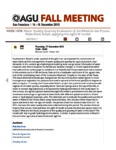Por favor, use este identificador para citar o enlazar este ítem:
http://www.alice.cnptia.embrapa.br/alice/handle/doc/1037591Registro completo de metadatos
| Campo DC | Valor | Lengua/Idioma |
|---|---|---|
| dc.contributor.author | CRUZ, P. P. N. | pt_BR |
| dc.contributor.author | FIGUEIREDO, R. de O. | pt_BR |
| dc.contributor.author | GREEN, T. R. | pt_BR |
| dc.date.accessioned | 2016-02-18T11:11:11Z | pt_BR |
| dc.date.available | 2016-02-18T11:11:11Z | pt_BR |
| dc.date.created | 2016-02-18 | pt_BR |
| dc.date.issued | 2015 | pt_BR |
| dc.identifier.citation | In: 2015 AGU FALL MEETING, 2015, San Francisco. E-posters... San Francisco: 2015. Ref. H43B-1478. | pt_BR |
| dc.identifier.uri | http://www.alice.cnptia.embrapa.br/alice/handle/doc/1037591 | pt_BR |
| dc.description | Southeastern Brazil is under a period of drought that has impacted the conservation of watersheds and the management of water quality and quantity for agricultural and urban demands. In this context agro-hydrological modeling tools can generate information of water response over time in response to climate and landuse changes. A 12-km2 watershed which has suffered from anthropogenic activities is the Ribeirão das Posses watershed that is located in the extreme south of Minas Gerais State and is a headwater catchment of the Jaguari river, one of the contributing rivers of the Cantareira Reservoir Complex in the state of São Paulo. This watershed had its landscape changed over the last century from native forests to more homogeneous vegetation for pastures and small crops and some forest plantations fragments with eucalyptus. Currently, the Conservative Waters project has planted some small areas with vegetation of native species, especially where there are springs and at the top of the hills, in order to recover degraded areas and improve the hydrogeochemistry in this study basin. In this context, the AgroEcoSystem-Watershed (AgES-W) model is presented to simulate the water movement and storage in agricultural watersheds with different spatial resolutions of land areas or hydrological responses units. The objectives are to evaluate the quality and quantity of water in Ribeirão das Posses Basin using measured data, then simulate these responses in space and time to test the AgES-W model. The period chosen for research was from 2011 to 2015, because the water quality data were collected during this period. The answers that we hope to find out are: How well does the AgES-W model simulate this Brazilian watershed in the tropics? What are the future prospects of the quality and quantity of water in this basin? The results will help to guide hydrological simulations in similar tropical environments in Brazil in this and other agricultural watersheds with AgES-W. | pt_BR |
| dc.language.iso | eng | eng |
| dc.rights | openAccess | eng |
| dc.subject | Watershed | pt_BR |
| dc.title | Water quality-quantity evaluation of the Ribeirão das Posses Watershed, Brazil, applying the AgES-W model. | pt_BR |
| dc.type | Resumo em anais e proceedings | pt_BR |
| dc.date.updated | 2016-04-15T11:11:11Z | pt_BR |
| dc.subject.thesagro | Água | pt_BR |
| riaa.ainfo.id | 1037591 | pt_BR |
| riaa.ainfo.lastupdate | 2016-04-15 | pt_BR |
| dc.contributor.institution | P. P. N. CRUZ; RICARDO DE OLIVEIRA FIGUEIREDO, CNPMA; T. R. GREEN. | pt_BR |
| Aparece en las colecciones: | Resumo em anais de congresso (CNPMA)  | |
Ficheros en este ítem:
| Fichero | Descripción | Tamaño | Formato | |
|---|---|---|---|---|
| 2015RA028.pdf | 208,67 kB | Adobe PDF |  Visualizar/Abrir |









